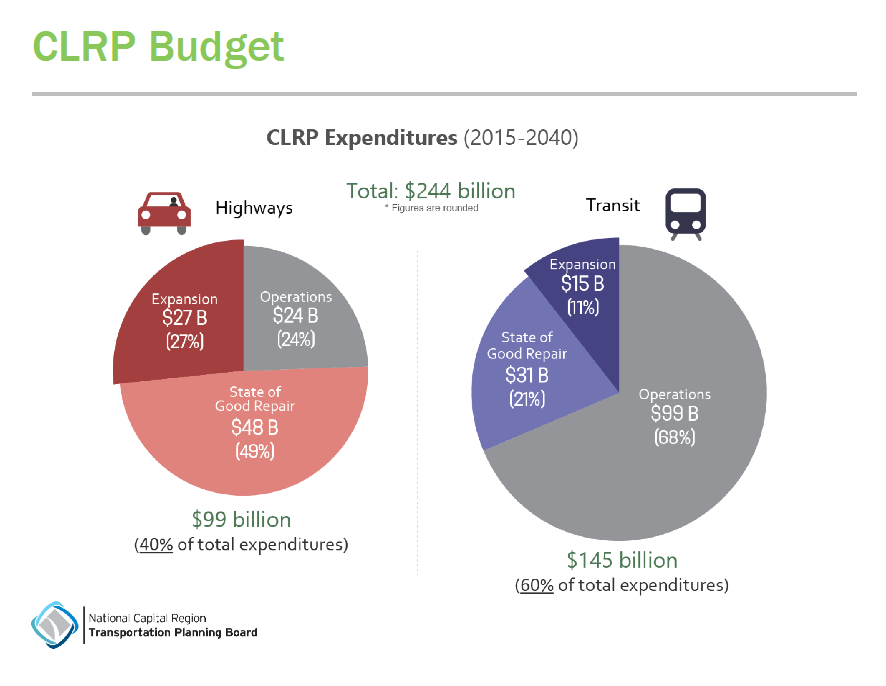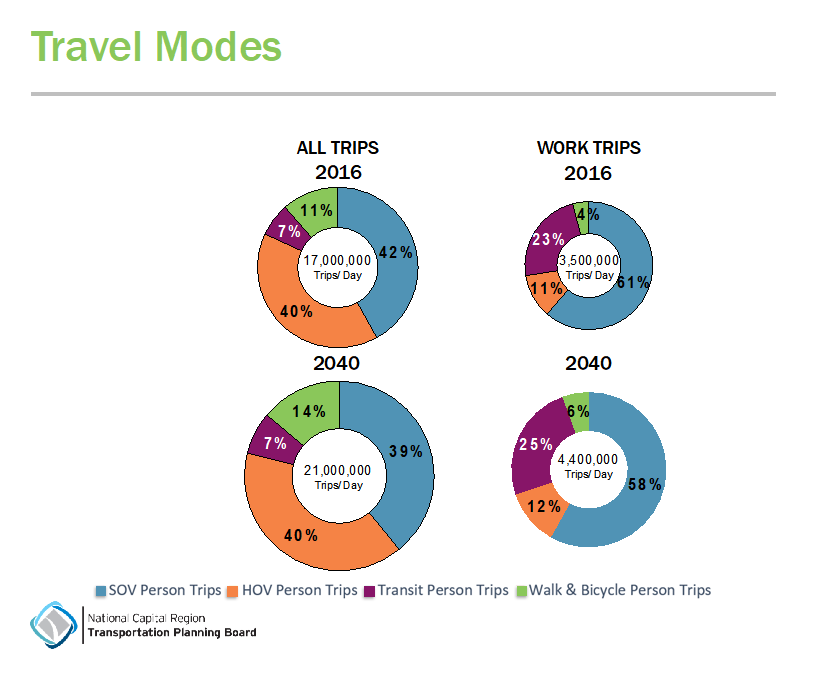By Neil Harris.
Transit is much more expensive to build than highways. It’s politically correct to focus on transit. But is it the best use of our tax dollars? Let’s look at the numbers.
Transportation planners in our region look at many. At the most recent Transportation Planning Board (TPB) meeting, there was a presentation on the ways that transportation plans are measured and approved factors – social equity, air quality, and many more. But when I asked if there was a cost-benefit analysis, it became clear that this did not appear to be on anyone’s list of measures.
By cost-benefit, I mean this: when you build a new transportation project, how much money does it cost to move people?
Over the last few weeks, I went back through some presentations and found the two slides shown below that have the numbers to tell an important story. I spent a lunch hour on the phone with TPB staff to verify that what I was seeing was accurate, and what it might mean. Here is what I learned from TPB’s data:
The DMV region plans to spend $42 billion to expand transportation capacity over the next 25 years, split between $27 billion on highway expansion and $15 billion on transit. This will result in 2.7 million more daily trips by auto and 300 thousand more daily trips in transit. By simple arithmetic, this means that it costs just over $10,000 to add capacity for another auto trip, and more than $53,000 to add another transit trip. Building transit capacity currently costs more than 5 times as much as highway capacity!
If this was the only factor that was important, then decisions would be easy. Any CEO would immediately allocate more money into adding highway capacity. Of course, it’s not the only factor. Not everyone can afford to travel by auto – we want lower-income people to be able to get to their jobs, so we need transit. Transit trips are less polluting than autos, although TPB’s data shows a steady decrease in auto pollutants thanks to greater efficiency and the growing number of electric, zero-emission vehicles.
The other key is that, for parts of our region, building new roads or even expanding existing ones is terribly difficult. Where would you put a new thoroughfare in DC, or in the close-in suburbs?
The costs I focused on so far are the capital costs for new projects. The same TPB information can be used for operating costs – how much it costs for each trip. It turns out that we’re going to spend $130 billion over the next 25 years on transit operations and repairs, about $5.2 billion annually, with capacity growing to 1.5 million daily trips, for a per-trip cost of about $9.50. Each time someone takes a transit trip, the government subsidizes the trip by that amount. We’ll spend $72 billion to maintain roadways during the same period, about $2.9 billion annually, to move up to 16.6 million trips/day. That comes to just under 50 cents per trip.
The operating cost information is useful in a couple of ways. At the same TPB meeting, the Commuter Connections presentation unveiled a new program, piloted in Howard County MD, where auto commuters can receive a $10 stipend for taking a rider along with them. That number is almost exactly right – it is comparable to the cost of putting someone on transit instead, but we don’t need to build more transit lines.
That is the kind of thinking we need. When we look at a new project or a new idea, does it move people more effectively than how we’re doing it now? Is it better for some reason, is it faster, is it cheaper?
For example, the TPB recently recommended that we find ways to encourage employers to let more people work from home. What if the government provided an incentive to the employers? With these numbers, we can make informed judgments about how much of an incentive makes fiscal sense.
The amount of money we have to transport people is limited, so we need to think carefully about optimization strategies to move people cost-effectively as well as focusing on all the other factors.
Neil Harris is a member of the Gaithersburg City Council and the Metropolitan Washington Council of Governments Transportation Planning Board.


